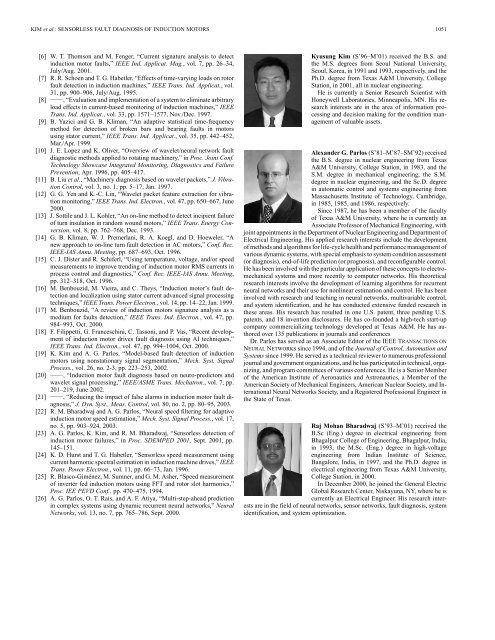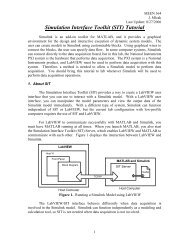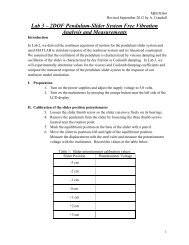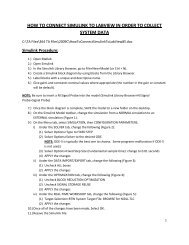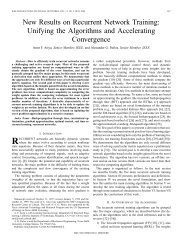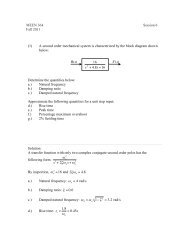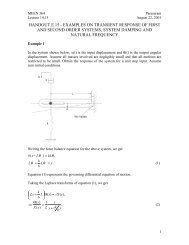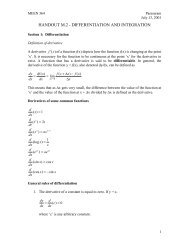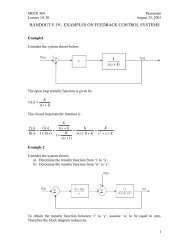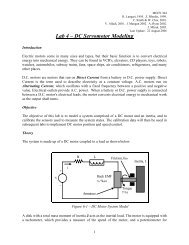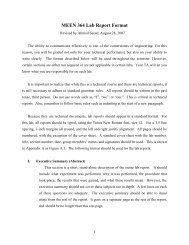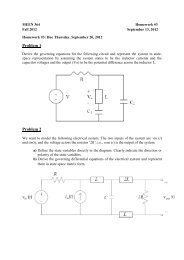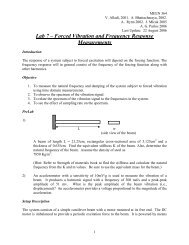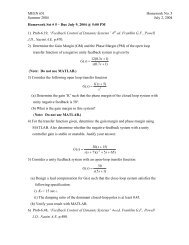Sensorless fault diagnosis of induction motors - Networked ...
Sensorless fault diagnosis of induction motors - Networked ...
Sensorless fault diagnosis of induction motors - Networked ...
You also want an ePaper? Increase the reach of your titles
YUMPU automatically turns print PDFs into web optimized ePapers that Google loves.
KIM et al.: SENSORLESS FAULT DIAGNOSIS OF INDUCTION MOTORS 1051[6] W. T. Thomson and M. Fenger, “Current signature analysis to detect<strong>induction</strong> motor <strong>fault</strong>s,” IEEE Ind. Applicat. Mag., vol. 7, pp. 26–34,July/Aug. 2001.[7] R. R. Schoen and T. G. Habetler, “Effects <strong>of</strong> time-varying loads on rotor<strong>fault</strong> detection in <strong>induction</strong> machines,” IEEE Trans. Ind. Applicat., vol.31, pp. 900–906, July/Aug. 1995.[8] , “Evaluation and implementation <strong>of</strong> a system to eliminate arbitraryload effects in current-based monitoring <strong>of</strong> <strong>induction</strong> machines,” IEEETrans. Ind. Applicat., vol. 33, pp. 1571–1577, Nov./Dec. 1997.[9] B. Yazici and G. B. Kliman, “An adaptive statistical time-frequencymethod for detection <strong>of</strong> broken bars and bearing <strong>fault</strong>s in <strong>motors</strong>using stator current,” IEEE Trans. Ind. Applicat., vol. 35, pp. 442–452,Mar./Apr. 1999.[10] J. E. Lopez and K. Oliver, “Overview <strong>of</strong> wavelet/neural network <strong>fault</strong>diagnostic methods applied to rotating machinery,” in Proc. Joint Conf.Technology Showcase Integrated Monitoring, Diagnostics and FailurePrevention, Apr. 1996, pp. 405–417.[11] B. Liu et al., “Machinery <strong>diagnosis</strong> based on wavelet packets,” J. VibrationControl, vol. 3, no. 1, pp. 5–17, Jan. 1997.[12] G. G. Yen and K.-C. Lin, “Wavelet packet feature extraction for vibrationmonitoring,” IEEE Trans. Ind. Electron., vol. 47, pp. 650–667, June2000.[13] J. Sottile and J. L. Kohler, “An on-line method to detect incipient failure<strong>of</strong> turn insulation in random wound <strong>motors</strong>,” IEEE Trans. Energy Conversion,vol. 8, pp. 762–768, Dec. 1993.[14] G. B. Kliman, W. J. Premerlani, R. A. Koegl, and D. Hoeweler, “Anew approach to on-line turn <strong>fault</strong> detection in AC <strong>motors</strong>,” Conf. Rec.IEEE-IAS Annu. Meeting, pp. 687–693, Oct. 1996.[15] C. J. Dister and R. Schiferl, “Using temperature, voltage, and/or speedmeasurements to improve trending <strong>of</strong> <strong>induction</strong> motor RMS currents inprocess control and diagnostics,” Conf. Rec. IEEE-IAS Annu. Meeting,pp. 312–318, Oct. 1996.[16] M. Benbouzid, M. Vieira, and C. Theys, “Induction motor’s <strong>fault</strong> detectionand localization using stator current advanced signal processingtechniques,” IEEE Trans. Power Electron., vol. 14, pp. 14–22, Jan. 1999.[17] M. Benbouzid, “A review <strong>of</strong> <strong>induction</strong> <strong>motors</strong> signature analysis as amedium for <strong>fault</strong>s detection,” IEEE Trans. Ind. Electron., vol. 47, pp.984–993, Oct. 2000.[18] F. Filippetti, G. Franceschini, C. Tassoni, and P. Vas, “Recent development<strong>of</strong> <strong>induction</strong> motor drives <strong>fault</strong> <strong>diagnosis</strong> using AI techniques,”IEEE Trans. Ind. Electron., vol. 47, pp. 994–1004, Oct. 2000.[19] K. Kim and A. G. Parlos, “Model-based <strong>fault</strong> detection <strong>of</strong> <strong>induction</strong><strong>motors</strong> using nonstationary signal segmentation,” Mech. Syst. SignalProcess., vol. 26, no. 2-3, pp. 223–253, 2002.[20] , “Induction motor <strong>fault</strong> <strong>diagnosis</strong> based on neuro-predictors andwavelet signal processing,” IEEE/ASME Trans. Mechatron., vol. 7, pp.201–219, June 2002.[21] , “Reducing the impact <strong>of</strong> false alarms in <strong>induction</strong> motor <strong>fault</strong> <strong>diagnosis</strong>,”J. Dyn. Syst., Meas. Control, vol. 80, no. 2, pp. 80–95, 2003.[22] R. M. Bharadwaj and A. G. Parlos, “Neural speed filtering for adaptive<strong>induction</strong> motor speed estimation,” Mech. Syst. Signal Process., vol. 17,no. 5, pp. 903–924, 2003.[23] A. G. Parlos, K. Kim, and R. M. Bharadwaj, “<strong>Sensorless</strong> detection <strong>of</strong><strong>induction</strong> motor failures,” in Proc. SDEMPED 2001, Sept. 2001, pp.145–151.[24] K. D. Hurst and T. G. Habetler, “<strong>Sensorless</strong> speed measurement usingcurrent harmonic spectral estimation in <strong>induction</strong> machine drives,” IEEETrans. Power Electron., vol. 11, pp. 66–73, Jan. 1996.[25] R. Blasco-Giménez, M. Sumner, and G. M. Asher, “Speed measurement<strong>of</strong> inverter fed <strong>induction</strong> <strong>motors</strong> using FFT and rotor slot harmonics,”Proc. IEE PEVD Conf., pp. 470–475, 1994.[26] A. G. Parlos, O. T. Rais, and A. F. Atiya, “Multi-step-ahead predictionin complex systems using dynamic recurrent neural networks,” NeuralNetworks, vol. 13, no. 7, pp. 765–786, Sept. 2000.Kyusung Kim (S’96–M’01) received the B.S. andthe M.S. degrees from Seoul National University,Seoul, Korea, in 1991 and 1993, respectively, and thePh.D. degree from Texas A&M University, CollegeStation, in 2001, all in nuclear engineering.He is currently a Senior Research Scientist withHoneywell Laboratories, Minneapolis, MN. His researchinterests are in the area <strong>of</strong> information processingand decision making for the condition management<strong>of</strong> valuable assets.Alexander G. Parlos (S’81–M’87–SM’92) receivedthe B.S. degree in nuclear engineering from TexasA&M University, College Station, in 1983, and theS.M. degree in mechanical engineering, the S.M.degree in nuclear engineering, and the Sc.D. degreein automatic control and systems engineering fromMassachusetts Institute <strong>of</strong> Technology, Cambridge,in 1985, 1985, and 1986, respectively.Since 1987, he has been a member <strong>of</strong> the faculty<strong>of</strong> Texas A&M University, where he is currently anAssociate Pr<strong>of</strong>essor <strong>of</strong> Mechanical Engineering, withjoint appointments in the Department <strong>of</strong> Nuclear Engineering and Department <strong>of</strong>Electrical Engineering. His applied research interests include the development<strong>of</strong> methods and algorithms for life-cycle health and performance management <strong>of</strong>various dynamic systems, with special emphasis to system condition assessment(or <strong>diagnosis</strong>), end-<strong>of</strong>-life prediction (or prognosis), and reconfigurable control.He has been involved with the particular application <strong>of</strong> these concepts to electromechanicalsystems and more recently to computer networks. His theoreticalresearch interests involve the development <strong>of</strong> learning algorithms for recurrentneural networks and their use for nonlinear estimation and control. He has beeninvolved with research and teaching in neural networks, multivariable control,and system identification, and he has conducted extensive funded research inthese areas. His research has resulted in one U.S. patent, three pending U.S.patents, and 18 invention disclosures. He has co-founded a high-tech start-upcompany commercializing technology developed at Texas A&M. He has authoredover 135 publications in journals and conferencesDr. Parlos has served as an Associate Editor <strong>of</strong> the IEEE TRANSACTIONS ONNEURAL NETWORKS since 1994, and <strong>of</strong> the Journal <strong>of</strong> Control, Automation andSystems since 1999. He served as a technical reviewer to numerous pr<strong>of</strong>essionaljournal and government organizations, and he has participated in technical, organizing,and program committees <strong>of</strong> various conferences. He is a Senior Member<strong>of</strong> the American Institute <strong>of</strong> Aeronautics and Astronautics, a Member <strong>of</strong> theAmerican Society <strong>of</strong> Mechanical Engineers, American Nuclear Society, and InternationalNeural Networks Society, and a Registered Pr<strong>of</strong>essional Engineer inthe State <strong>of</strong> Texas.Raj Mohan Bharadwaj (S’93–M’01) received theB.Sc (Eng.) degree in electrical engineering fromBhagalpur College <strong>of</strong> Engineering, Bhagalpur, India,in 1993, the M.Sc. (Eng.) degree in high-voltageengineering from Indian Institute <strong>of</strong> Science,Bangalore, India, in 1997, and the Ph.D. degree inelectrical engineering from Texas A&M University,College Station, in 2000.In December 2000, he joined the General ElectricGlobal Research Center, Niskayuna, NY, where he iscurrently an Electrical Engineer. His research interestsare in the field <strong>of</strong> neural networks, sensor networks, <strong>fault</strong> <strong>diagnosis</strong>, systemidentification, and system optimization.


